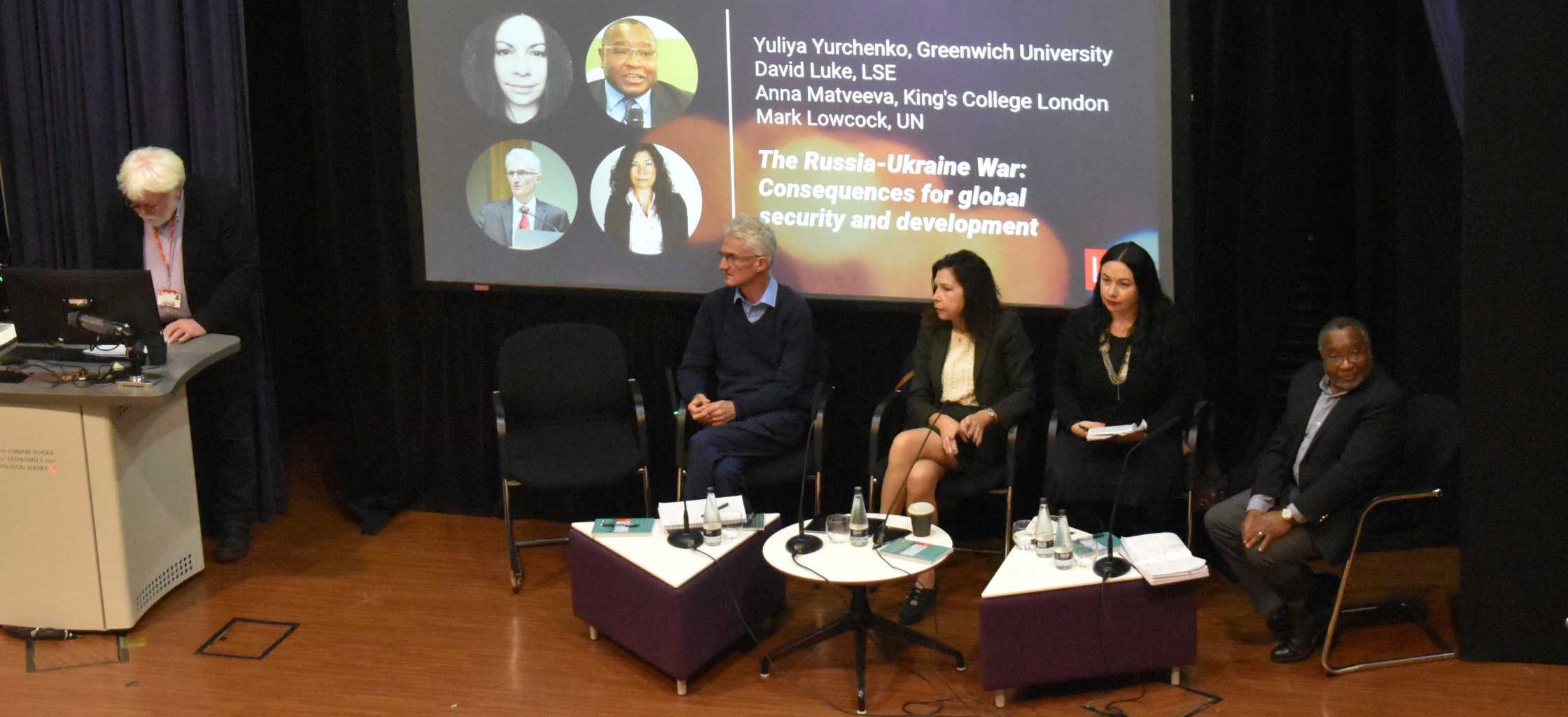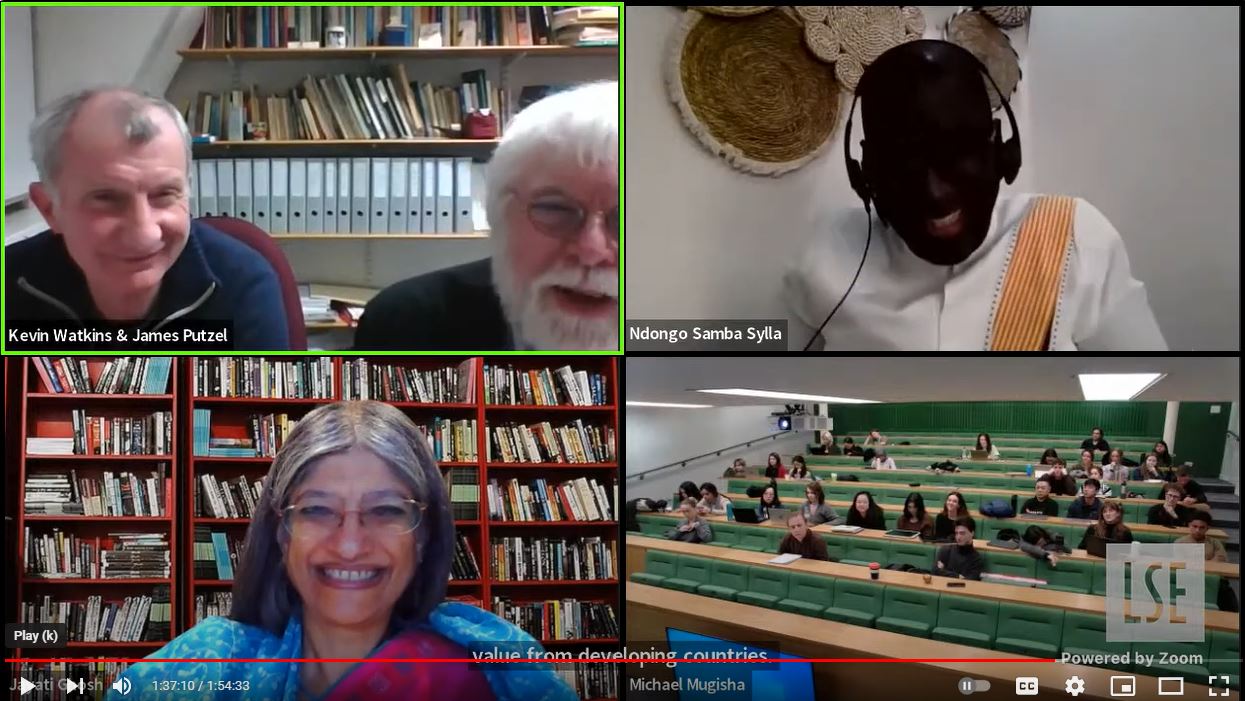On Friday 1 December, Keyu Jin, Yunnan Chen and Weiwei Chen joined us for a panel discussion on ‘Development or Dependence?: China’s Investment and development finance in Africa’ as part of the Cutting Edge Issues in Development Lecture Series for 2023/24. Chaired by Tin El-Kadi. Read what MSc students Alexa Andanar, Casey Johnson, Peter Bland and Xuefei Zhang took away from the lecture below.
You can watch the lecture back on YouTube or listen to the podcast.
I hail from the Philippines, where the Belt and Road Initiative has been a oft-repeated foreign policy term in the past six years. However, it is currently viewed as controversial, with the Philippines exiting the BRI to favour Western and Japanese loans. In this context, it was intriguing to hear the insight of academics who are experts in the Chinese development economics field during last Friday’s Cutting Edge lecture. It was particularly interesting to draw comparisons with China’s active development infrastructure in Africa, a top recipient of Chinese aid.
The Belt and Road Initiative (BRI) is a Chinese strategy that aims to connect Asia with countries in Africa and Europe through infrastructure investment in ports, railways, and hydropower, ultimately to increase its geopolitical influence. As a frequent consumer of Western media, it is safe to say that my perspective on China’s development finance has been skewed – that it is a form of “debt trap diplomacy”, where developing countries are caught in unsustainable loans which then allows China to seize their strategic assets.
However, last week’s lecture offered a rather unorthodox way of thinking about Chinese development loans. Firstly, while critics cite the case of Sri Lanka’s Hambantota Port as the perfect example of Chinese debt trap diplomacy, Yunnan Chen explained that in actuality, there was no evidence of debt or equity swaps, and that Chinese lenders have been generous with debt restructuring terms. Keyu Jin echoed this, where she offered alternative reasons for Sri Lanka’s sovereign debt – existing internal economic challenges and the integration into global capital markets – factors separate from Chinese lending. Generally, it is enlightening to note that compared to Western debtor countries, Chinese loans are lower-cost, with lower-interest rates and less “strings attached”, as Keyu Jin noted.
Finally, Wei Wei Chan offered an explanation for Chinese development finance through her own research, highlighting the key challenges in studying the phenomenon. Methodological Nationalism, for instance, favours Chinese exceptionalism over heterogeneity. Critics fail to realise that beyond the Chinese state, the BRI involves a variety of Chinese investors, actors, and capital, and that success of projects depends on the local and structural context within African countries that implement and shape Chinese aid.
Taking a non-Western perspective on Chinese development infrastructure allows us to see the flip-side: Chinese loans have spurred infrastructure development (with tens of thousands of kilometers of bridges and railways in Africa alone) and have filled the financing gap otherwise disregarded by Western countries. When melding geopolitics and development, it is always more beneficial to take a balanced approach so impacts can be neutrally evaluated.
Alexa Andanar
In the wake of China celebrating the Belt and Road Initiative’s 10th anniversary, the sentiment surrounding Chinese investment in the continent of Africa has become increasingly divisive. One of the salient aspects of the debate is whether this type of investment is a new type of “debt trap”. Are countries in Africa experiencing a repeat of the debt-generating development experienced with Western lending, or is this an opportunity to achieve real strides in development with a new set of lenders? The presenters in this Cutting-Edge Lecture, Keyu Jin, Yunnan Chen, and Weiwei Chen, detailed their responses to this debate.
Yunnan Chen led the discussion in illustrating how Chinese lending in various African countries has fundamentally challenged the OECD and its role as the primary lender. She highlighted the complex nature of Chinese lending as it is spread across various actors through a range of financial instruments. The focus of most aid and finance projects is on hard infrastructure. Not only does this address the current void as Western donors are retreating from these sectors, but it also closely aligns with the interests of the states in which they are investing. When disaggregating the data, it becomes clear that the amount of debt to Chinese investors is not as great of an issue as is being reflected in mainstream rhetoric.
Weiwei Chen continued this discussion, further emphasizing that Chinese lending represents as a fundamental shift, targeting regions overlooked by usual lending sources. Dr. Chen shared the importance of critically breaking down investment to the micro level to analyse its implications. The drivers of investment in various African states depend on the background of the firms with which they are engaging as well as contextual factors within each state.
Keyu Jin concluded the lecture by focusing on the economic environment in China and how it will continue to shape investment. China accounts for only 17% of Africa’s external debt, and African countries owe three times more to private western lenders than they do to firms in China. As there is a global reversal of the “savings glut” and China is experiencing economic slowdown, the reality of their investment will also change. Investment is shifting to small-scale projects with increased conditionalities. This further supports the point made by the three presenters that the scale of Africa’s indebtedness to China will not reach the levels it has with Western lenders.
Casey Johnson
China is no monolith: this is the leitmotif of last Friday’s Cutting-Edge lecture, delivered wonderfully by Yunnan Chen and Weiwei Chen. They are speaking just after the ten-year anniversary of China’s Belt and Road Initiative (BRI), and it is this programme’s particular interest in Africa that they have been asked to address.
One may have thought it easy, given the tone of much of the Western press around the BRI, to predict how the lecture would go: China is engaging in opportunistic, perhaps predatory lending to weaker, impoverished nations – maybe with an illustrative reference to Sri Lanka’s Hanbantota port; but in truth nothing is so simple that it can be reduced to such an easy rhetorical point.
Yunnan and Weiwei, rather, gave us an expansive and sophisticated look at China’s conception of “development finance”, its motivations and the different actors involved. We were brought through the former by Yunnan, who by way of a fairly Byzantine spider diagram, illustrated the architecture of Chinese overseas investment.
More important than where the money is coming from, though, was where it is going. Hydropower and railways are not only sectors in which China has a comparative advantage, but they align perfectly with the development strategies of African nations – and they have also been largely ignored by traditional sources of investment over the last few decades. Of course, there’s a lot of consternation in the West about the way China operates, given how much of their funding comes with “no strings attached,” but if the OECD is going to vacate these areas, one could argue that it has little ground to stand on; and besides, if China sees itself as a rising superpower, why “sit at the table where the dishes have already been prepared”, as Yunnan said during her presentation.
Weiwei brought us through the latter. Far from the slightly stereotypical idea of a single, unitary body brooding over every last detail, Chinese development finance is in fact made up of a variety of different actors of a variety of different sizes. This includes both state- and privately-owned firms (or mixed), who may be motivated, at turns, by seizing new markets, strategic assets or profit, and who need to adapt to the context of the African nations in which they’re investing. The truth is that there’s no easy way to grasp all the ins and outs, but an open mind and thoroughly engaging with as broad a range of data as possible is a start. Above all, after two hours of unpacking, analysing and re-analysing, what I most took away from the lecture was that complex thinking is the only way to deal with such complex topics.
Peter Bland
Over the past decade, the significant increase in aid provided by China and the Belt and Road initiative has attracted the attention of the media, scholars, and policymakers around the world. Due to the differences in the way China and OECD countries approach foreign aid and China’s lack of data transparency, Chinese foreign aid has aroused massive scepticism among Western media. In the face of such narratives, this week’s 3 guest lectures told us an inside story, which is different from the one provided by Western media. By offering us with credible statistics and vivid examples, they challenge the stereotypes of Chinese foreign aid and remind us of the value of Chinese foreign aid.
The first presenter, Yunnan Chen, raised the example of the so-called ‘Chinese debt trap’ in Sri Lanka’s Hanbantota port and explained why the common perception was wrong. In 2012, China became Africa’s largest bilateral creditor, which has raised fear over Chinese lending as a geostrategic tactic to gain control over key assets in Africa. Different from the opinions in mainstream media, Yunnan Chen argued that the claims of the ‘debt trap’ were pure hyperbole since the debt struggles Sri Lanka faced were overwhelmingly due to its private bondholders.
The next speaker, Weiwei Chen explored the topic from a more academic perspective. After conducting ground-based comparative analysis in Ethiopia and Angola, she finds that Chinese Foreign Direct Investment has a potentially transformational effect on African economies, but the potential impact depends much on the existence of a coherent policy framework to manage Foreign Direct Investment in the host countries, which can be manifested in the comparison between Angola and Ethiopia.
Last but not least, Keyu Jin, discussed Chinese foreign aid from a broader perspective. By drawing connections between Chinese foreign aid and its domestic economic structures and policies, she pointed out that any generalization of Chinese foreign aid is dangerous, and it is always important to consider the diversity of sources, channels, and modalities when analysing Chinese foreign aid.
A key takeaway from the lecture is that amid all the misunderstanding and stigmatization of Chinese foreign aid, we need to examine the Chinese model of aid from a scientific basis. I believe this cutting-edge lecture can be seen as a good starting point for us to learn more about Chinese foreign aid and conduct relevant studies in the future.
Xuefei Zhang
The views expressed in this post are those of the author and in no way reflect those of the International Development LSE blog or the London School of Economics and Political Science.





